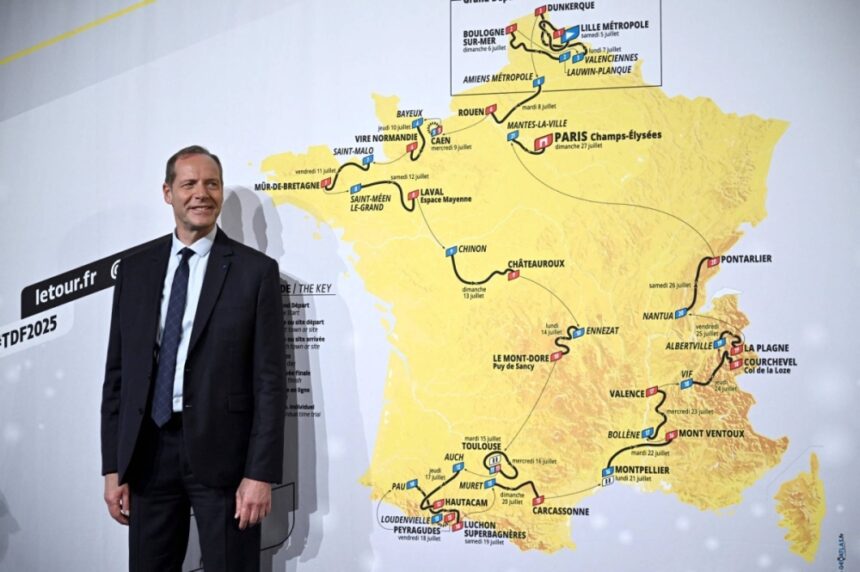The 2025 Tour de France promises to be one of the most compelling editions in recent history, with a route that combines innovation, tradition, and brutal elevation gains. Officially scheduled from June 28 to July 20, 2025, the 112th edition of the world’s most prestigious cycling race features a historic start in Lille, a demanding mix of mountain stages, and a dramatic finale outside Paris due to the Olympic Games.
Historic Grand Départ in Lille
For the first time in over 60 years, the Grand Départ will take place in Lille, in the northern region of Hauts-de-France. The opening weekend will include:
- Stage 1: A flat but tactical circuit in and around Lille, ideal for sprinters but potentially windy enough to split the peloton.
- Stage 2: A transition through cobblestone sectors and rolling terrain reminiscent of Paris-Roubaix—early chaos and GC (General Classification) risk.
Northern France’s industrial and cobbled roads will demand early focus from teams, with echelons, mechanical risks, and aggressive breakaways likely to define the first days.
Mid-Race Mountains: Pyrenees and Massif Central
The race heads south through Normandy and the Loire Valley, before entering the Massif Central, with punishing climbs and unpredictable weather.
Key mountain battles begin in the Pyrenees around Stage 10–12, where riders will face iconic climbs like:
- Col du Tourmalet
- Hautacam
- Pla d’Adet
These stages are expected to create the first real gaps among GC contenders. The Massif Central, with its short but steep gradients, will favor aggressive riders and puncheurs aiming for stage wins.
Alpine Drama and a High-Altitude Showdown
The final week brings the Alps, where the Tour could be won or lost. The 2025 route includes some of the most legendary ascents in Tour history, including:
- Alpe d’Huez (likely in Stage 17 or 18)
- Col de la Madeleine
- Col du Galibier
- Col de la Loze
One new addition is a speculative Summit Finish at Les 2 Alpes, offering a modern classic finale with high altitude and unpredictable weather.
Expect a mix of long ascents, high-speed descents, and team tactics at play. Back-to-back mountain stages will test rider endurance and support team strategy.
Time Trials and Key Flat Stages
The individual time trial (ITT) will return in 2025 with at least one long-stage TT, possibly placed between the mountain phases to keep the GC dynamic. Rumors suggest a 38–45 km ITT in central France, with rolling terrain that favors strong all-rounders like Remco Evenepoel or Tadej Pogačar.
Flat stages in Troyes, Bordeaux, and Nîmes will offer chances for sprinters, while transitional stages could suit breakaway specialists and stage hunters.
No Paris Finish: A Historic First
Due to preparations for the 2024 Paris Olympic Games, the 2025 Tour will not finish in Paris—breaking a tradition that dates back to 1975. Instead, the final stage is expected to conclude in Nice, along the Mediterranean coast, echoing the route used in the 2024 edition.
- Stage 21 in Nice is rumored to be a time trial finish, adding suspense to the last day and reminiscent of the dramatic 1989 LeMond-Fignon finale.
Total Distance and Overall Profile
While the official total distance has yet to be confirmed, early projections estimate the 2025 Tour de France will span approximately 3,400 km, with:
- 6–7 flat stages
- 5–6 mountain stages
- 2 individual time trials
- 3–4 hilly/transition stages
- 2 rest days and 1 transfer day
Climbers and time trial specialists will have equal opportunity, while teams will need depth and tactical flexibility to navigate the varied terrain.
In Summary
The 2025 Tour de France route offers a blend of history, innovation, and brutality. With a Grand Départ in Lille, iconic mountain climbs in the Pyrenees and Alps, and a groundbreaking finale in Nice, it promises one of the most open and unpredictable editions in years. For fans and riders alike, it will be a Tour defined by resilience, daring attacks, and tactical brilliance.












